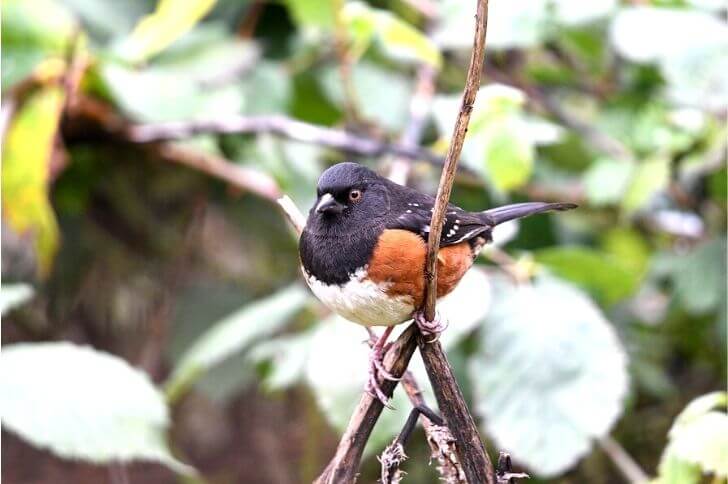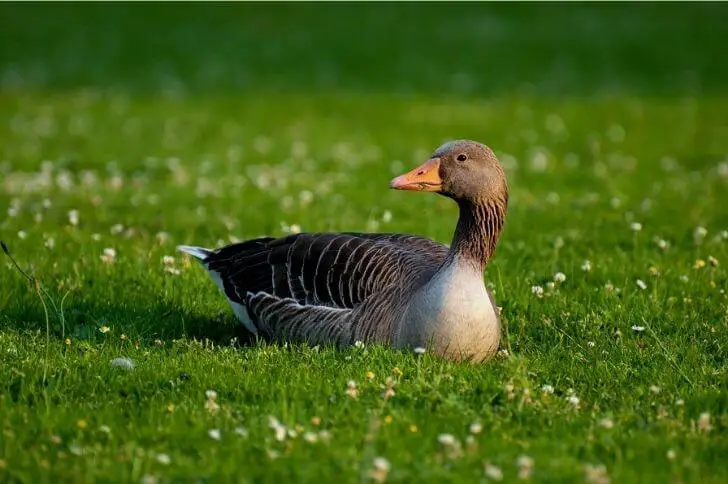There are many different species of birds that live on Cape Cod, including seabirds, songbirds, and raptors. Birds play an important role in the food web, help to control insect populations, and provide pollination services.
The Cape Cod region is an important stopover point for migratory birds, and provides critical habitat for many threatened and endangered species. Below we’ll look at different birds of Cape Cod, their plumage, feeding, nesting and also where to go bird watching. So get your birding journal and let’s get started.
List of Birds in Cape Cod
1. Piping Plovers

Piping plovers are a small, stocky shorebird with a short neck and bill. In Cape Cod, these birds have been listed as federally threatened due to their decreasing numbers. You can identify a piping plover by looking at:
Identification:
They have pale gray upperparts, white underparts, and a black band on their neck. Notice the small crown and a dark mustache. They have a small dark bill with an orange base. Also their feet are orange. Immature plovers are duller without the crown and dark necklace.
Other facts:
These birds are migratory birds. You can spot them along Cape beaches during summer months.
Piping plovers nest on beaches, in sand dunes, and on rocky shores. The female lays 3-4 eggs in a scrape in the sand. Eggs are incubated for 21-25 days. The chicks are precocial and can feed themselves soon after they hatch.
Piping plovers are protected under the Migratory Bird Treaty Act. Their populations have declined due to habitat loss, disturbance from beachgoers, predation, and coastal development.
2. Northern Cardinal
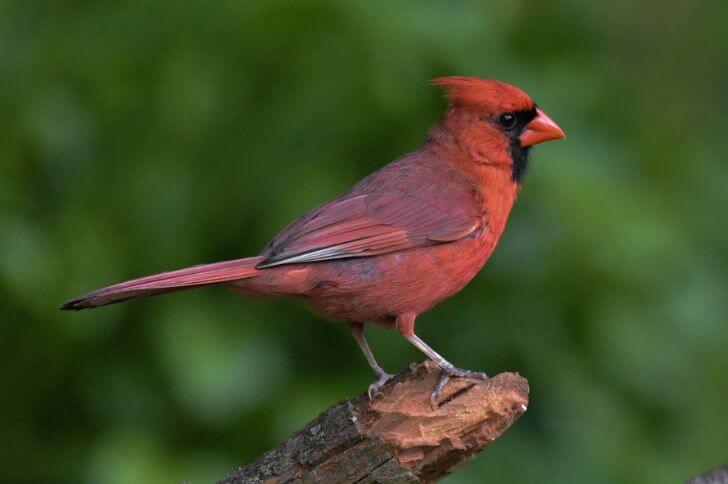
In Cape Cod, the northern cardinal is one of the most popular backyard birds. Males are easier to identify.
Identification:
The male’s red plumage stands out in any landscape and his songs are a familiar sound of summer. Males also spot a long tail and a black face. Their blood red crest is another way you can identify them.
In contrast, female cardinals are overall brown with a red bill, wingtips and tail. These birds average 8.3-9.1 inches in length. They have a 12.1 wingspan.
Other facts:
These birds are resident breeders in Cape Cod. Cardinals are also one of the few bird species that mate for life. When do they lay eggs? These birds of cape cod raise two broods between March and July.
During this period, you can watch as the grayish white eggs hatch, revealing naked, clumsy babies. Within a few weeks, the cardinal juveniles will leave the nest.
Cardinals are found in woodlands, gardens, and backyards across much of the region. They eat insects, seeds, berries, and fruits.
3. Downy Woodpecker

One of the most interesting and unique birds in Cape Cod is the downy woodpecker. An important part of the ecosystem, there is so much you can learn about this species of birds.
Identification:
This bird is small, only about 5-6 inches in length, but it has a very big personality. Like other woodpeckers, its plumage is mostly black and white. Belly is plain white. Notice the red spot on the male’s head; it’ll help you tell the sexes apart.
It gets its name from the downy feathers. These feathers help to keep the bird warm in cold weather.
Other facts:
The downy woodpecker is very curious and playful, and it is not afraid to come close to humans. It is also a very good flier, and it can often be seen chasing other birds or flying acrobatically.
When do they nest? Egg laying may start as early as March or as late as May. You can spot woodpecker babies after two weeks of incubation.
Also, like other woodpeckers, these birds on Cape Cod are known for their tapping and drumming sounds. This avian species prefers bark beetles, corn earworm, berries and grains.
4. White-breasted Nuthatch

Are there white-breasted nuthatches in Cape Cod? Yes, they are common woodland birds in this region.
Identification:
The White-breasted Nuthatch is a small bird with a big personality. This handsome little bird has a blue-gray back and wings, with a white breast and belly. The male and female birds look alike, although the male usually has a slightly darker head than the female.
Other facts:
This feisty little bird is not afraid to stand up to much larger birds, and will often chase them away from its territory. The White-breasted Nuthatch is also known for its acrobatic abilities, and is often seen clinging upside down to tree trunks or branches.
They can be found in woodlands, parks, and even suburban areas across Cape Cod. Like many species, the White-breasted Nuthatch is an important part of the forest ecosystem.
5. Green-winged Teals

Green winged teals are one of the most beautiful and fragile birds of Cape Cod. These birds are only found in certain parts of the region and their populations are declining rapidly.
Identification:
These Cape Cod shore birds are striking. Their plumage allows them to stand out among other sea birds of Cape Cod. Sexes are sexually dimorphic. Males are black and white with a chestnut-green head and broad dark bill.
Females are a heavily streaked brown with broad bill. Both sexes are 12-15.3 inches long.
Interesting facts:
There are many reasons for this Cape Cod’s bird declining number, but the biggest threat to these birds is habitat loss. Green winged teals rely on wetlands for their breeding and nesting grounds, but development and pollution are destroying these critical habitats.
Without wetland habitats, green winged teals will continue to decline in numbers until they disappear entirely from the landscape. This would be a tragic loss, not just for the birds themselves, but for the ecosystem that depends on them.
6. Black-capped Chickadee
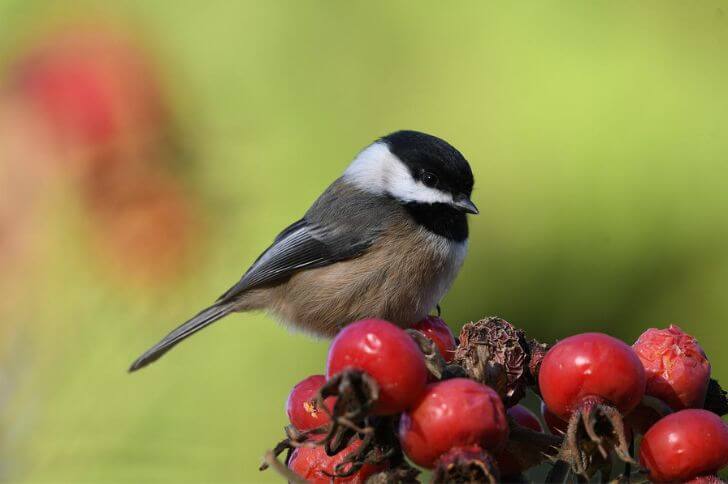
Named the National Bird of the State, the black-capped chickadee is found in huge numbers in Cape Cod as well as other areas. This Massachusetts state bird has distinctive features that’ll help you identify it.
Identification:
The black capped chickadee is a small, sprightly bird. These birds are easily recognizable by their black crowns and white cheeks. They are about 5 inches long, slightly larger than the black-chinned hummingbird.
Other facts:
Chickadees are acrobatic little birds, often seen clinging upside down to tree branches in search of food.
These cheerful little birds are not only fun to watch, but they also play an important role in the ecosystem. Black capped chickadees are insectivores, which means they help control the populations of harmful insects. They also eat seeds and berries, dispersing these important plant foods throughout the forest.
Chickadees are social creatures, often forming close bonds with other members of their flock. So next time you see a black capped chickadee, take a moment to appreciate these amazing creatures.
7. Common Goldeneye

Are there diving ducks in Cape Cod? Yes, common goldeneyes are a common bird along the Cape Cod canal as well as ponds and marshes.
Identification:
Goldeneyes are medium-sized sea birds of Cape Cod that breed across the region. The species is named for its bright golden eyes, and males also have a distinctive green head while the female’s is brown.
Males have black and white plumage while females are mostly grayish. Their feet are dark and webbed.
Other facts:
Goldeneyes are expert divers, able to reach depths of over 60 feet in search of food. During the breeding season, these shorebirds form pairs and nest in tree cavities near water. Both parents care for goldeneye babies.
Once the chicks fledge, the adults often form large flocks and fly south for the winter months. Common goldeneyes are not currently considered to be at risk of extinction.
8. Red-winged Blackbird
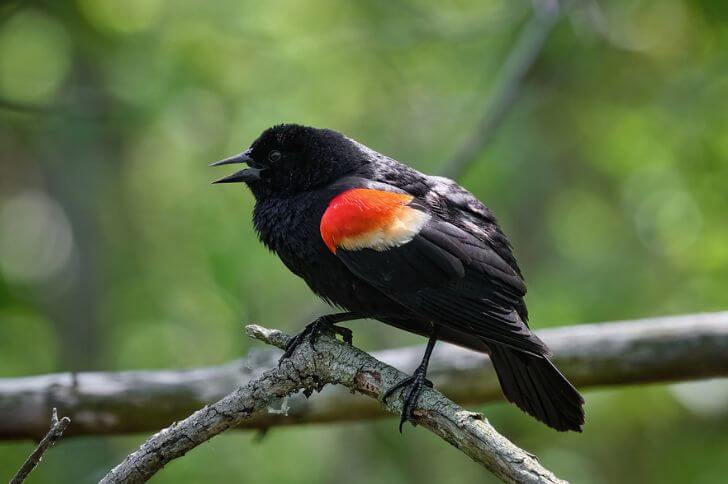
What is the most common bird in Cape Cod? Red-winged blackbirds are fairly common in this region especially in spring. Also, they are resident, found throughout the year.
Identification:
The male has distinctive red epaulets on its wings. Their bodies are all black with a small black bill. Females are brown and heavily streaked. Note the yellowish tinge around its face and shoulders.
Other facts:
Both sexes are found in marshes and wetlands across Cape Cod, where they build their nests in trees or shrubs.
Red-winged blackbirds are omnivorous, eating a variety of insects, fruits, and seeds. They play an important role in seed dispersal and insect control. These birds are also known to be aggressive towards other birds and animals, particularly during nesting season.
9. Common Tern

Another type of Cape Cod sea bird you should plan to watch are the common terns. They are widely distributed in the area.
Identification:
According to Mass Audubon, these birds have a black cap, white forehead and red bill. The back and wings are gray, while the underparts are white. Note the orange-red feet and forked tail.
Interesting facts:
It breeds in coastal areas, often near estuaries or rivers. In Cape Cod you can find them from late July through October. In late October, they’ll leave for warmer regions. The Common tern feeds on small fish, which it catches by diving into the water. It typically nests on rocky outcrops or beaches.
10. Yellow Warbler
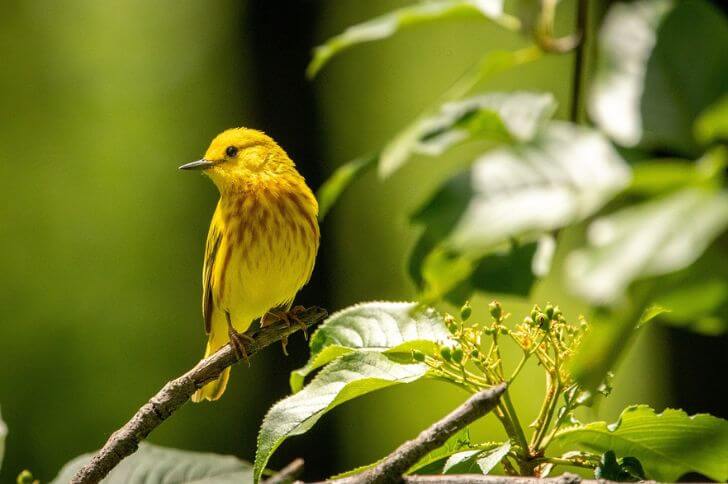
What are the songbirds of Cape Cod? Yellow warblers are fairly common in the area during spring time. They are the only warblers that eat waxy berries. This allows them to come to the island earlier than other songbirds and leave later.
Identification:
Despite their small size, yellow warblers are feisty little birds. They are overall 4.7-5.1 inches long. They are overall yellow with beady eyes. Note the short bill.
Other facts:
Yellow warblers are not only pretty to look at, but they are also important members of the Cape Cod wildlife. These insectivores help to control the populations of harmful insects, making them an important part of the food chain.
They will defend their nesting territories vigorously against intruders, even those much larger than themselves. This courage makes them a popular bird with birdwatchers and nature lovers alike.
11. Eastern Bluebird

A welcome sight in winter, the eastern bluebird is a gorgeous bird that you can watch in these islands. These birds of cape cod have distinctive features.
Identification:
The adult male bird has blue feathers on its back and wings, and a rusty breast. Their bellies are white and feet dark. Notice the black mask around their eyes. Females are brownish with hints of blue plumage on their head, wings and tail.
Other facts:
The eastern bluebird is found in open woodlands and fields, where it builds its nest in tree cavities. The bird eats insects, berries, and fruits.
To attract them to your yard, we recommend you get large nest boxes that they can fit. Also, get a few feeders to feed a small flock and ensure its is guarded from predators.
12. Marsh Wren
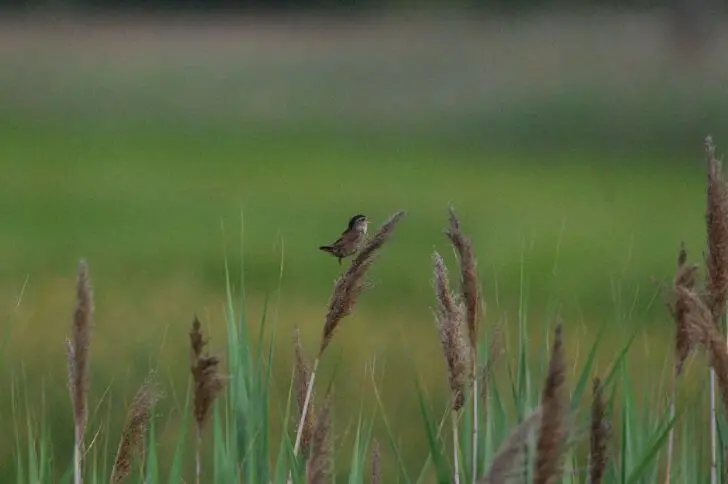
With a rounded-body and buzzy trills, marsh wrens are another common bird on Cape Cod. Though secretive, here are a few facts we know about them.
Identification:
Marsh wrens are small birds, measuring only about 4-5 inches in length. They have brown upperparts and pale underparts. Their tail is corked and long, and they have a long, curved bill. Male marsh wrens are more brightly colored than females.
Other facts:
These sprightly little birds are known for their loud, metallic songs which they use to defend their territories. Though they are often hidden amongst the reeds, their bold songs and distinctive plumage make them a favorite of birdwatchers.
These small birds of Cape Cod are most active in the early morning hours, when they can be heard singing from the reeds.
13. Virginia Rail
When can you see Virginia rails in Cape Cod? During the winter months.
Identification:
The Virginia rail is a medium-sized bird that is found in marsh lands. The adult is up to 10 inches long. They are mostly brownish-gray with dark streaks. Note their orange-black bills.
Other facts:
It is a shy bird that is seldom seen by people. The Virginia rail is a secretive bird that hides in the dense vegetation of the marshes. It is most active at dawn and dusk, when it forages for insects, spiders, and other small invertebrates.
During nesting season, females lay their eggs in a nest that she builds in the marshy vegetation. The Virginia rail is an interesting bird that is worth learning more about.
14. Mourning Doves
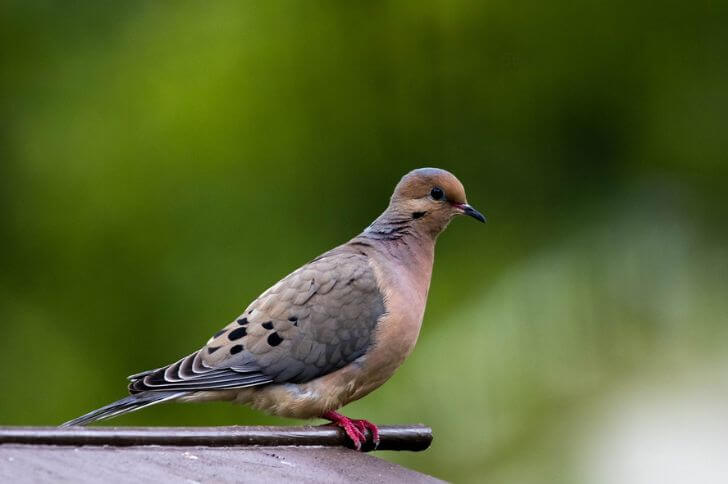
The Mourning Dove is a common bird found across North America. They are also found in large numbers within the islands. They are gentle creatures that coo and mate for life.
Identification:
These birds are medium size, with short legs and a long tail. Their plumage is gray and brown, with black spots on their wings. Mourning doves are slender compared to other birds in their family.
Interesting facts:
Mourning doves are named for their distinctive call which sounds like they are moaning. They are seed eaters and can often be seen feeding on the ground. In the wild, they typically live around 2-5 years, but in captivity, they have been known to live up to 20 years old.
15. Bufflehead

Cute and compact, buffleheads are interesting ducks of Cape Cod that are a joy to watch. Here is how you can spot them.
Identification:
The Bufflehead is a small American duck that is easily recognizable by its large head and puffy cheeks. Adult male have white, green and purplish heads. The rest of the body is black and white. Female buffleheads are grayish white.
Other facts:
Each summer, this bird comes to Cape Cod from Canada. It is most commonly found near fresh or salt marshes, where it feeds on small fish, crustaceans, and insects. The Bufflehead is an excellent swimmer and diver, and often dives to depths of 60 feet or more in search of food.
It is also known to be an excellent flying bird.
16. American Woodcock

With a long bill and a round body, the American woodcock is a shorebird that can survive in upland areas. Apart from its shape, here are other ways to identify this small Cape Cod bird.
Identification:
The American woodcock, also known as the timberdoodle, is a small, chunky bird with a long bill and short legs. It is mostly gray-brown with a gray collar.
Other facts:
It is found in woods and wetlands across Cape Cod. The woodcock is a skillful flier and an accomplished leaper, able to take off from the ground with little effort.
It is most active at dawn and dusk, when it can be seen probing for food in wet areas with its long bill. The bird’s diet consists mostly of earthworms and other invertebrates. The woodcock breeding season generally lasts from February to May. Nests are usually built on the ground in densely vegetated areas.
During the fall and winter months, the woodcock can be found in fields and forests where it feeds on insects that are attracted to the light.
17. Great Blue Heron

Great blue herons are a large wading bird that stands up to four feet tall.
Identification:
This majestic bird is easily recognized by its long neck and legs, blue-gray plumage, and yellowish bill. Note the head plume and black crown.
Other facts:
The great blue heron is a skilled hunter, stalking fish, rodents, and other small animals in shallow water before spears them with its sharp bill.
These regal birds often nest in colonies near bodies of water, where they build large nests out of sticks and twigs. Great blue herons are fairly social creatures and can often be seen gathered together in groups, flying in formation or feeding side-by-side.
Though their numbers have declined in recent years due to habitat loss and hunting pressure, the great blue heron remains a widespread and popular bird species.
18. Whimbrel

Where can you find whimbrels in Cape Cod? In the wellfleet bay wildlife sanctuary. Large and quiet, these birds are easily identifiable.
Identification:
Whimbrels are small to medium-sized shorebirds with long legs and bill. They have brown streaked upperparts with white underparts. Chest and throat are also streaked. Also its bill is curved, which comes in handy when foraging for food.
Other facts:
The Whimbrel is a beautiful yet endangered bird. Their diet consists of insects, crabs, and other small animals.
Whimbrels lay 3-5 eggs in a nest on the ground. The female incubates the eggs for 22-28 days. The chicks fledge at about 28 days old.
There are only an estimated 20,000 to 30,000 Whimbrels remaining in the wild today. This number is decreasing due to habitat loss, hunting, and climate change.
FAQs
Where can I go bird watching in Cape cod?
Best bird watching spots in Cape Cod include:
- Wellfleet Bay Wildlife Sanctuary
- Race Point
- Monomoy National Wildlife Refuge
- Scusset State Reservation
What kinds of birds are on Cape Cod?
Cape Cod is home to songbirds such as the yellow warbler, raptors, shorebirds such as piping plovers and diving ducks.
Where are birds on Cape Cod?
You can find shorebirds on the beaches, raptors, ducks, and songbirds in bird sanctuaries, and common birds like the Northern Cardinal can be seen on trails and backyards.
What kinds of seagulls are on Cape Cod?
Most seagull species nest in Cape Cod. The most common seagulls include herring gulls, ring-billed gulls, laughing gulls, and great black-backed gulls.
https://en.wikipedia.org/wiki/Common_goldeneye
https://www.massaudubon.org/learn/nature-wildlife/birds/northern-cardinals
Hi fellow bird watcher. Welcome to our small corner of the world. At the spanishbirdguides.com our mission is to share with other bird watchers the things we love about birds, where to go bird watching within the United States, and more. I’d also love to hear from you. Feel free to contact me about your bird watching escapades, share videos, photos and more.
